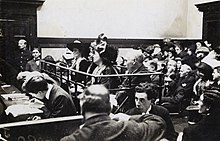Criminal Justice Act 1925
 | |
| Long title | An Act to amend the law with respect to the administration of criminal justice in England, and otherwise to amend the criminal law. |
|---|---|
| Dates | |
| Royal assent | 22 December 1925 |
Status: Amended | |

The Criminal Justice Act 1925 (15 & 16 Geo.5 c.86) is an Act of the Parliament of the United Kingdom. Most of it has been repealed.
Section 36 of the Act makes it an offence to make a false statement to obtain a passport. The maximum sentence is two years.
Section 41 prohibits the taking of photographs in a court in England and Wales, save for Supreme Court.[1] In September 2011, Lord Chancellor Kenneth Clarke announced that the government intended to partially repeal this ban in order to increase the public's understanding of the administration of justice.[2] Initially, filming of the handing down of judgments in the Court of Appeal will be permitted, with a view that filming of sentencing remarks will eventually be permitted in the Crown Court.[3]
Other provisions of the Act deal with criminal procedure against corporations, the defence of marital coercion (since abolished), and unlawful possession of pension documents.
References[]
- ^ This exception was added by section 47(1) of the Constitutional Reform Act 2005 when the court was created.
- ^ UKPA, "Clarke to lift court filming ban", Google News (6 September 2011)[dead link]
- ^ BBC News, "Court broadcast of judges' remarks to be allowed", news.bbc.co.uk (6 September 2011)
External links[]
- Text of the Criminal Justice Act 1925 as in force today (including any amendments) within the United Kingdom, from legislation.gov.uk. .
- English criminal law
- United Kingdom Acts of Parliament 1925
- United Kingdom statute stubs
- English law stubs